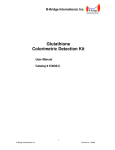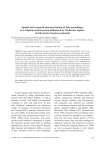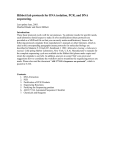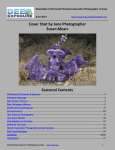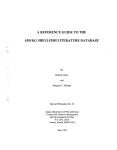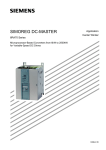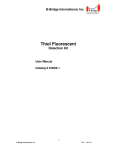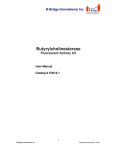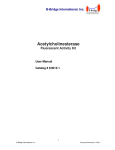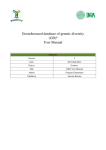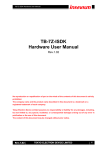Download Glutathione S-Transferase Fluorescent Detection Kit - B
Transcript
B-Bridge International, Inc. Glutathione S-Transferase Fluorescent Detection Kit User Manual Catalog # K3008-1 1 B-Bridge International, Inc. Glutathione S-Transferase 110629 TABLE OF CONTENTS Intended Use 3 Background 3 Assay Principle 3 Kit Components 3 Materials Required 4 Precautions 4 Reagent Preparation 4 Sample Preparation 5 Assay Protocol 5 Calculations 5 Typical Standard Curve Example 6 Notice to Purchaser This product is to be used for Research Purposes Only. It is not to be used for Drug or Diagnostic Purposes, nor is it intended for Human Use. B-Bridge products may not be resold, modified for resale, or used to manufacture commercial products without the express written consent of B-Bridge International, Inc. EXCEPT AS OTHERWISE EXPRESSLY SET FORTH IN THIS USER MANUAL, B-BRIDGE DOES NOT MAKE ANY REPRESENTATION OR WARRANTIES OR CONDITIONS OF ANY KIND, EITHER EXPRESSED OR IMPLIED, WITH RESPECT TO THE PRODUCTS, OR INFORMATION DISCLOSED HEREUNDER, INCLUDING, BUT NOT LIMITED TO, THE IMPLIED WARRANTIES OF MERCHANTABILITY, FIT FOR A PARTICULAR PURPOSE, OR NONINFRINGEMENT OF THE INTELLECTUAL PROPERTY RIGHTS OF THIRD PARTIES. B-Bridge International, Inc. All Rights Reserved. 2 B-Bridge International, Inc. Glutathione S-Transferase 110629 INTENDED USE The B-Bridge Glutathione S-Transferase Fluorescent Detection Kit (cat.# K3008-1) quantitatively measures Glutathione S-Transferase (GST) in human urine, serum, EDTA, heparin plasma, toadfish liver (Opsanus tau), oyster hemolymph samples, and most cell lysates. BACKGROUND The Glutathione S-Transferase (GST) family of isozymes function to detoxify and neutralize a wide variety of electrophilic molecules by mediating their conjugation with reduced glutathione. Human GSTs are encoded by 5 gene families, expressing in almost all tissues as four cytosolic and one microsomal forms. Dividing the family by isoelectric points, the basic alpha (pI 8–11), the neutral mu (pI 5–7) and acidic pi (pH<5) classes are populated by additional subclasses, each isozyme displaying differential specificity for given electrophilic molecules. Given its pivotal role in ameliorating oxidative stress/damage, GST activity has been repeatedly investigated as a biomarker for arthritis, asthma, COPD, and multiple forms of cancer, as well as an environmental marker. Examination of GST isoforms and activity in human cancers, tumors and tumor cell lines has revealed the predominance of the acidic pi class. Furthermore, this activity is thought to substantially contribute to the innate or acquired resistance of specific neoplasms to anticancer therapy. ASSAY PRINCIPLE The Glutathione S-Transferase Fluorescent Activity kit is designed to quantitatively measure the concentration of GST present in a variety of samples. Please read the complete kit insert before performing this assay. 1. Sample or standard added to well in microtiter plate. 2. The reaction is initiated with the addition of the glutathione fluorescent detection reagent. 3. Incubate for 30 minutes at room temperature and read fluorescent signal at 460 nm with 390 nm excitation wavelength. 4. Calculate Glutathione S-Transferase concentration from standard curve. KIT COMPONENTS Black Half-Area 96-well plate 1 plate Glutathione S-Transferase Standard (10 U/mL) 50 uL GST Detection Reagent - Stored in a desiccator. 1 vial Assay Buffer 45 mL Glutathione (20mM) 300 uL Store above components at 4°C Dry DMSO 2 mL - Dry Dimethyl sulfoxide solvent over molecular sieves Store DMSO tightly capped at room temperature 3 B-Bridge International, Inc. Glutathione S-Transferase 110629 MATERIALS REQUIRED BUT NOT SUPPLIED - 96-well plate reader capable of reading fluorescent emission at 510 nm with excitation at 390 nm - Software for converting raw relative fluorescent unit (FLU) readings from the plate reader and carrying out four parameter logistic curve (4PLC) fitting PRECAUTIONS This kit should only be used by qualified personnel who have had laboratory safety instruction. The complete User Manual should be read and understood before using this product. Dimethyl sulfoxide is a powerful aprotic organic solvent that has been shown to enhance the rate of skin absorption of skin-permeable substances. Wear protective gloves when using the solvent especially when it contains dissolved chemicals. In all cases, please consult your institution’s safety procedures for working with hazardous chemicals. REAGENT PREPARATION Standard Preparation GST Standards are prepared by labeling seven test tubes as #1 through #7. Briefly spin vial of standard in a microcentrifuge to ensure contents are at bottom of vial. Pipet 380 µL of Assay Buffer into tube #1 and 200 µL into tubes #2 to #7. Carefully add 20 µL of the Glutathione S-Transferase Standard to tube #1 and vortex completely. Take 200 µL of the GST solution in tube #1 and add it to tube #2 and vortex completely. Repeat these serial dilutions for tubes #3 through #7. The concentration of GST in tubes 1 through 7 will be 500, 250, 125, 62.5, 31.25, 15.61 and 7.81 mU/mL. Use all Standards within 1 hour of preparation. Standard Standard Standard 1 2 3 Reagent Buffer Volume 380 µl 200 µl 200 µl GST Standard 20 µl Standard 1 200 µl Standard 2 200 µl Standard 3 Standard 4 Standard 5 Standard 6 Final Concentration (mU/mL) 500 250 125 Standard 4 200 µl Standard 5 200 µl Standard 6 200 µl Standard 7 200 µl 200 µl 200 µl 200 µl 200 µl 62.5 31.25 15.625 7.81 Detection Reagent Remove the vial of Detection Reagent from the desiccator and add 300 µL of the dry DMSO to the vial. Vortex thoroughly. Store any unused reconstituted Detection Reagent at 4°C in the desiccator for no longer than 2 weeks. Dilute one part of reconstituted Detection Reagent 1:10 into nine parts of Assay Buffer. 150 µL of Detection Reagent should be diluted with 1.35 mL of Assay Buffer to use half the plate. Discard any excess diluted Detection Reagent. Glutathione Dilute one part Glutathione stock provided 1:10 into nine parts of Assay Buffer. 150 µL of Glutathione stock should be diluted with 1.35 mL of Assay Buffer to have enough GSH to be able to read half the plate. Discard any excess diluted glutathione. 4 B-Bridge International, Inc. Glutathione S-Transferase 110629 SAMPLE PREPARATION Any samples requiring larger dilutions or with GST activities outside the standard curve range should be diluted further with Assay Buffer to obtain readings within the standard curve. Urine Samples Samples that are not clear or that contain visible particulate should be centrifuged prior to using. Urine samples should be diluted ≥ 1:2 in Assay Buffer by adding one part of urine to one part of Assay Buffer. Sample values should be normalized for urinary volume to urinary creatinine levels. Our Urinary Creatinine Detection Kit, K302-1. performs simple, safe and accurate determination of urinary creatinine levels. Serum and Plasma Samples Samples that are not clear or that contain visible particulate should be centrifuged prior to using. Fresh serum or EDTA and heparin plasma are separated by centrifugation at 600 x g for 10 minutes. Transfer the serum or plasma from the red blood cells into fresh tubes. The serum or plasma may be stored at -80°C or analyzed immediately. Serum or plasma should be diluted with assay Buffer at a dilution of ≥ 1:2. Cell Lysates 6 Washed cell pellets are resuspended at 10-40x10 cells/mL in Assay Buffer (we used Jurkats at 10 6 x 10 cells/mL) and are lysed by vigorous vortexing, freeze/thaw cycling or other suitable disruption method. Resulting centrifuged lysate supernatents are measured at appropriate dilutions. The protocol might require adjustment for other cell types. If protein determinations are to be made on the samples, we would recommend using higher number of cells and lysing in your normal PBS-based lysis buffer and determining protein concentration, prior to additional dilutions in Assay Buffer to measure GST activity. Use all samples within 2 hours of dilution. ASSAY PROTOCOL- FREE AND TOTAL GSH 1. Pipet 50 µL of treated samples or standards into duplicate wells in the plate. 2. Pipet 50 µL of Assay Buffer into duplicate wells as the Zero Standard. 3. Add 25 µL of the Detection Reagent to each well using a repeater or multichannel pipet. 4. Add 25 µL of GSH to each well using a repeater or multichannel pipet. 5. Gently tap the sides of the plate to ensure adequate mixing of the reagents. 6. Incubate at room temperature for 30 minutes. 7. Read the fluorescent signal from each well in a plate reader capable of reading the fluorescent emission at 460 nm with excitation at 370-410 nm. Please contact your plate reader manufacturer for suitable filter sets. 8. Use the plate reader’s built-in 4PLC software capabilities to calculate GST activities for each sample. CALCULATIONS Average the duplicate FLU readings for each standard and sample. Create a standard curve by reducing the data using the 4PLC fitting routine on the plate reader, after subtracting the mean FLUs for the zero standard. The concentrations obtained should be multiplied by the dilution factor to obtain neat sample values. 5 B-Bridge International, Inc. Glutathione S-Transferase 110629 TYPICAL STANDARD CURVE 6 B-Bridge International, Inc. Glutathione S-Transferase 110629






